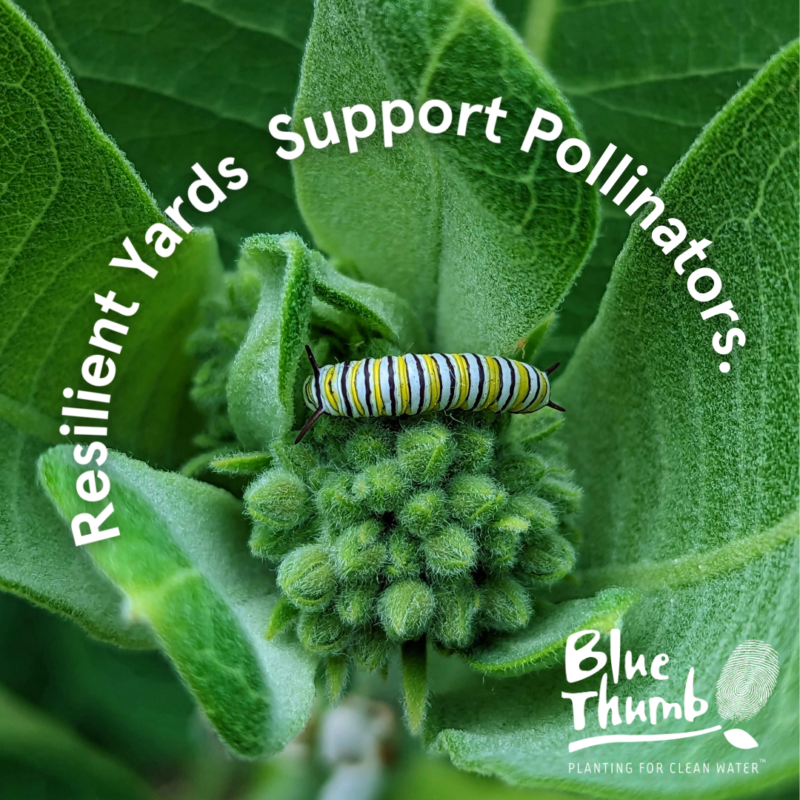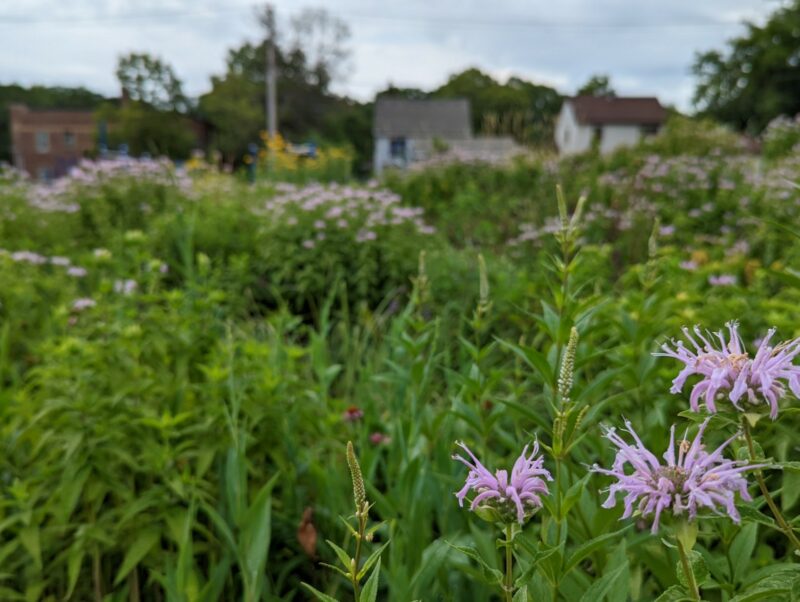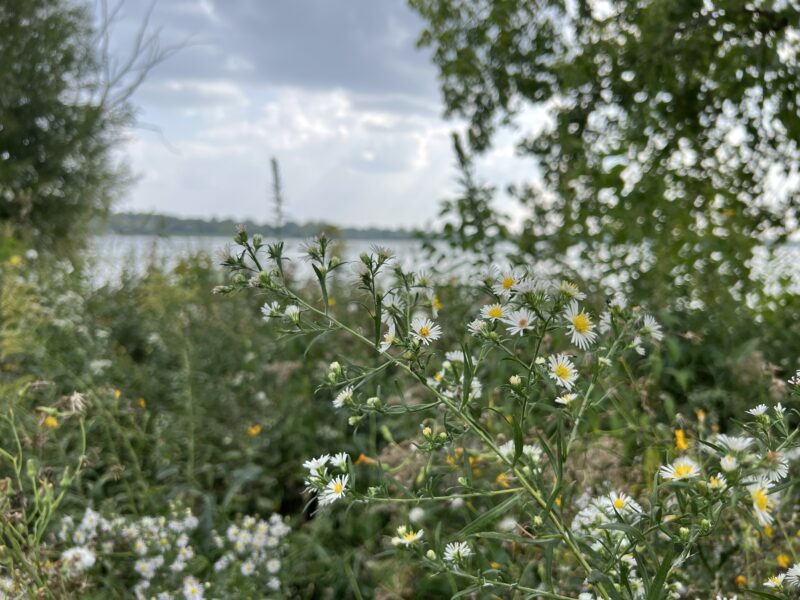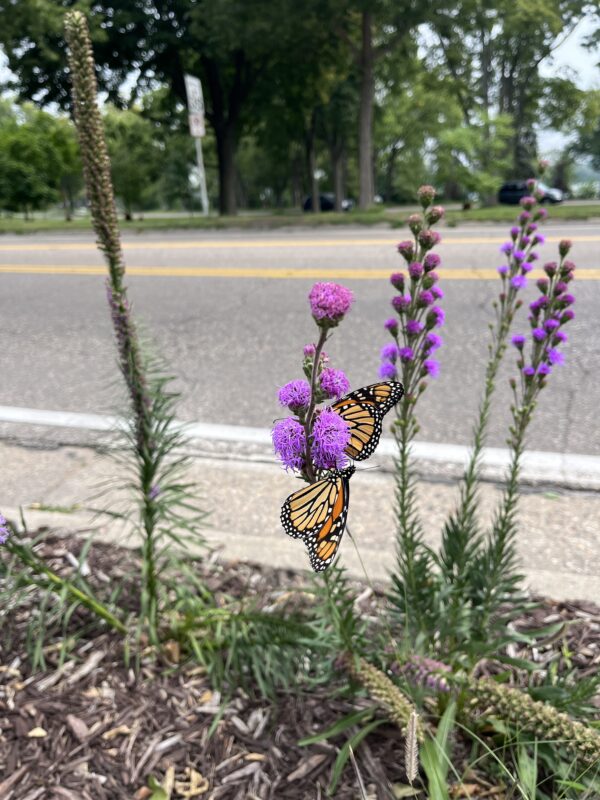
What do the yards look like in your neighborhood? Depending on where you live, you may see swathes of turfgrass lawns in shades of greens to browns, or perhaps neatly arranged garden beds with neon-bright flowers. But maybe you’ve noticed a different kind of yard starting to spread, less flashy but with something different always in bloom, and a popular hub for butterflies, bees, and birds.
There’s a new outdoor aesthetic rising across suburban streets and rural lots, community gardens, and urban balconies. It’s multi-layered, complex, textured, and teeming with life. It is beautiful, but it’s not the clean-cut beauty of white picket-fenced “American Dream” yards. These yards upend old beauty standards with a different type of organic enchantment, offering intrigue all year long. They are resilient yards.
Resilient yards are less susceptible to impacts of environmental change, from drought and excessive heat to flooding rains. They are filled with native plants that have been growing in Minnesota for a long time and have beneficial relationships with the region’s seasonal patterns, pollinators, and soil. Aboveground, native plants provide habitat and food for wildlife. Belowground, the deep roots of native plants capture carbon and help clean pollutants from soil, making it healthier over time.
“A resilient landscape is one that is allowed to evolve and transform over time in response to disturbances, all while still supporting a diversity of life and a healthy environment,” says Jack Rosenwinkel, a landscape designer who works with Metro Blooms and Blue Thumb. “[Resilient yards] keep the relationships between organisms, people, and systems like water and nutrient cycles intact.”
Whether you have a small patio or a large outdoor space, you can support these living relationships in the face of environmental challenges like climate change and development. Blue Thumb’s spring workshops offer step-by-step guidance for beautifying your landscape while planting for pollinators and clean water. This year, we’re offering three workshops: Resilient Yards, Turf Alternatives, and Resilient Shorelines. All workshops are available on a sliding scale. Let’s take a look at each:
 Resilient Yards: Learn how to install and maintain a native pollinator planting. After registering, you’ll gain access to the Resilient Yards Online Learning Series. The self-paced learning modules cover how to assess your site and choose a project location, design a pollinator garden with native plants, and incorporate clean water practices that redirect runoff and conserve water.
Resilient Yards: Learn how to install and maintain a native pollinator planting. After registering, you’ll gain access to the Resilient Yards Online Learning Series. The self-paced learning modules cover how to assess your site and choose a project location, design a pollinator garden with native plants, and incorporate clean water practices that redirect runoff and conserve water.
They’ll prepare you for a live virtual or in-person session with expert landscape designers and Minnesota Master Gardeners, where you’ll get one-on-one time in a small group to share your project plans, ask questions, and receive feedback.
“Each participant takes turns talking about their projects, ideas, and roadblocks they might be facing,” Rosenwinkel explains. “Inevitably, each participant learns a lot about their own yard just by listening in to hear about one another’s projects!”
The Resilient Yards workshop is a unique opportunity to consult with a landscape designer at a low cost. “Talking with a landscape designer can give you the confidence needed to start your project, avoid roadblocks and remove some of the trial and error involved in home landscaping and gardening projects,” shares Rosenwinkel.
 Turf Alternatives: Walk through the process of converting a conventional turfgrass lawn into a flowering pollinator lawn. Turfgrass requires frequent mowing, requires high water and fertilizer inputs to stay green, has poor water infiltration, and provides little to no nutritional value to pollinators.
Turf Alternatives: Walk through the process of converting a conventional turfgrass lawn into a flowering pollinator lawn. Turfgrass requires frequent mowing, requires high water and fertilizer inputs to stay green, has poor water infiltration, and provides little to no nutritional value to pollinators.
“A lawn is a desert to pollinators,” shares workshop presenter Bob Dahm (Organic Bob) with Organic Lawns By Lunseth. “Many small pollinators become landlocked in the vast oceans of suburban lawns.” Recent years of drought and spreading grub infestations have also degraded many turfgrass lawns, which are expensive to repair or replace, explains Dahm. “Many people see it as an opportunity for change.”
Switching to a pollinator lawn or low-maintenance turf alternative promotes both pollinator health and water quality while minimizing your yard work in the long term. Attend a Turf Alternatives workshop for a live presentation and Q&A session that covers your options, and explore online learning modules with videos and downloadables that assist you on your project.
 Resilient Shorelines: Geared for folks who live on or near shoreline, this workshop gives step-by-step guidance for installing a native planting project, including conducting a shoreline site assessment, selecting native plants, navigating local regulations, and more.
Resilient Shorelines: Geared for folks who live on or near shoreline, this workshop gives step-by-step guidance for installing a native planting project, including conducting a shoreline site assessment, selecting native plants, navigating local regulations, and more.
“Our shorelines are a powerful tool for having clean and healthy lakes,” says Beth Carreño, Senior Program Manager, Comfort Lake – Forest Lake Watershed District, who helped develop Resilient Shorelines content. Natural shorelines slow down the flow of stormwater, reducing erosion and sedimentation in our lakes. They filter water, reducing pollutants. And they provide habitat for wildlife and pollinators while deterring nuisance species like Canada Geese.
All levels of experience are welcome, whether you’re unfamiliar with shoreline restoration or looking for new ideas. Carreño hopes that workshop participants can leave with new skills and knowledge, as well as the connections to get the help and answers they need. “All our actions on land impact our waters, and their little stretch of shoreline is critical to our success,” she shares.
Native plants offer many benefits for people and the environment, including supporting wildlife, inviting pollinators, improving soil quality, water quality, and reducing maintenance costs. By acting as stewards of our individual outdoor spaces, we contribute to greater ecological health that connects us all.
“I love seeing folks empowered by these workshops,” Carreño shares, “getting the resources and knowledge to protect the things they love most—our waters.”
Dahm is also inspired by workshop participants. “I am greatly encouraged by citizens who are determined to begin the process of healing our ecology by using their small resources and their family’s living space to help species who are so vulnerable.,” he says. “My hope is that people will leave with the tools, resources, confidence and inspiration to make changes and encourage others to do the same. The hardest thing to change is the human heart, yet once changed, it becomes the driving force for ecological regeneration.”
By building confidence and sharing resources with one another, we can create connected corridors of clean water landscaping and pollinator habitat across our neighborhoods. Virtual and in-person workshops run through May. Register on our Events Page.
– Megan Reich, Metro Blooms Communications and Program Manager

